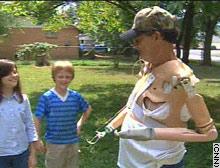 Image
from CNN.com
Image
from CNN.com
|
Last September, Jesse Sullivan, a Chicago area man who had lost both
arms in an electrical accident, received a pair of prosthetic arms.
Though Mr. Sullivan had used artificial limbs before, his new pair has
a new feature. His former prostheses, like most, were controlled
mechanically with springs and cables attached to other areas of his body.
Mr. Sullivan was able to manipulate his old artificial limbs by carefully
coordinating the movement of those other areas. But his new arms
are wired directly into his nervous system!
Surgeons implanted wires in Mr. Sullivan shoulder muscles, which were
still intact after the accident. These wires were then connected
to the miniature computer which controls his new, motorized prostheses.
By detecting and responding to the small electrical impulses which Mr.
Sullivan would normally use to control his own, natural limbs, his new
robotic arms will be able to react to the signals coming from his brain,
just as his original arms did. |